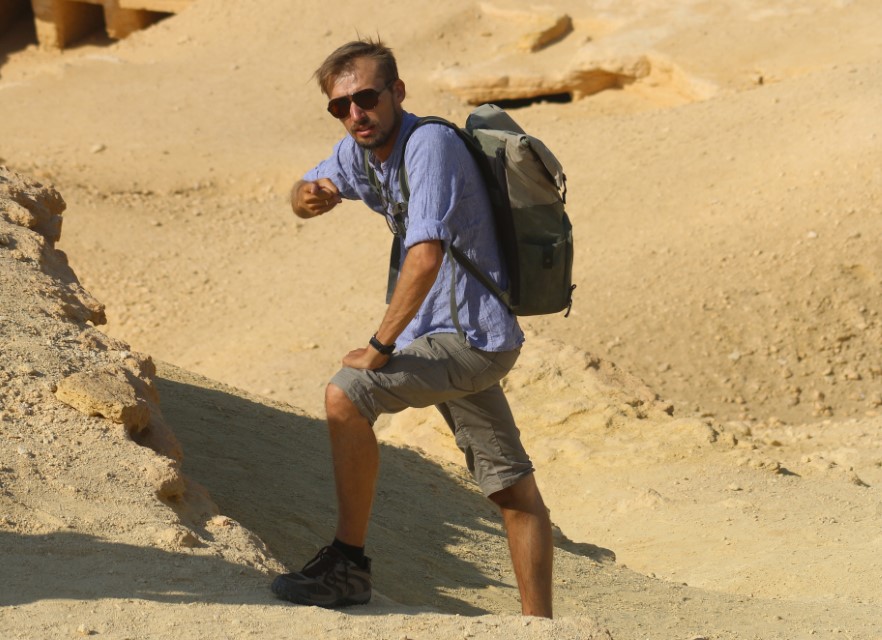-
Principal Investigator: Dr. Mariusz Gwiazda
Contact: m.gwiazda2@uw.edu.pl

Project term:
July 2021 to June 2025
Budget:
PLN 561 072
Funding:
National Science Centre Poland, Opus 19, 2020/37/B/HS3/00306

-

Marmora Bizantina. Identification of the origin of marble and its use in the secular and sacral space in southern Levant of the early Byzantine period (4th–7th century AD)
Keywords: marble, southern Levant, early Byzantine period, trade, archaeometry
The main goal of the project is to determine the importance of marble and recreate the image of trade in it in southern Levant of the early Byzantine period (4th–7th century AD). In the ancient world, this material meant both petrographically true marble, i.e. metamorphosed limestone, as well as other rocks with a decorative appearance (e.g. limestone, porphyry and granite). Such raw material did not occur naturally in this area or in its immediate surroundings and was imported from parts of the Mediterranean World hundreds of kilometers away. Given this fact, it is reasonable to ask why so much effort was being put into it. Understanding what marble was used for and in what kind of buildings is key in this regard. Were they architectural details and liturgical equipment imported primarily for the needs of the large quantities of churches built at that time? Or was it commonplace to use this material, e.g. in thermal baths and residential buildings?
In the context of studying the early Byzantine economy, the key task is to determine the origin of marble imported into southern Levant. The most important mining centers for this raw material were located in today’s western Turkey, Greece, Egypt and Tunisia. Laboratory analysis of marble samples discovered in southern Levant will be carried out to reveal which of these quarries provided the raw material. Furthermore, the project will attempt to determine whether individual mining centers specialized in the production of specific types of goods such as columns, altars and vessels.
It is also important to determine what the marble trade in southern Levant looked like. Meaning, was this material available only in the Mediterranean coastal region near the port cities it first reached? Or was it being transported in large quantities inland? Our knowledge of the mechanisms governing trade in this material will help determine whether its consumers were located mainly in cities or in villages and in secluded monasteries.
Although this material was one of the most expensive building materials in antiquity, the issue of its use between the 4th and the 7th century in southern Levant is still largely unrecognized. Filling this research gap is important for understanding the significance of this material and trading it in the late antiquity. So far, similar research has been conducted mainly in the field of trade in ceramic vessels and their content and monetary circulation. Including another category of goods in this context, in the form of marble items from the vast and important region, which was southern Levant, will be an important element in the discussion on the economics of the Mediterranean World in the early Byzantine period.
The project will involve a diverse methodology, taking into account traditional archaeological, historical and art historian analyzes, as well as modern archeometric methods, statistical and geographical studies. One of the source bases includes published marble monuments discovered in today’s Lebanon, Israel and Jordan. They will be catalogued and classified, taking into account their function and form. Such systematization of the material will allow answering the most important questions related to the use of and trade in this material in southern Levant. Knowledge on this subject will also be expanded to include information from inscriptions or hagiographic texts mentioning which marble and under what circumstances was imported from overseas. Determining where marble was imported from will be based on laboratory analysis. The study will apply e.g. stable carbon, oxygen and strontium isotopes measurements, as well as petrographic and chemical characterization. This will involve the use of objects sampled from excavations in Lebanon, Israel and Jordan. The analysis of marble distribution will use models of terrain accessibility and calculations of the distance between consumer settlements and ports responsible for distribution of such goods.
Associated events:Lectures and conference presentations:Project bibliography:Gwiazda, M., Poggio, A., & Wielgosz-Rondolino, D. (eds.). (2023). Marble use, trade and distribution in the Eastern Mediterranean during the Late Antiquity, Volume 32, No. 1.
Gwiazda, M. (2023). Methods of quantitative and qualitative analyses of ancient marble finds assemblages. The cases of early Byzantine Hawara, Porphyreon, and Philoxenite. Polish Archaeology in the Mediterranean, vol. 32, no. 1, pp. 243-271. https://doi.org/https://doi.org/10.37343/uw.2083-537X.pam32.1.10.
Gwiazda, M. (2023). Marmora Bizantina: A digital corpus of marble finds from the southern Levant. Polish Archaeology in the Mediterranean, vol. 32, no. 1, pp. 181-195. https://doi.org/https://doi.org/10.37343/uw.2083-537X.pam32.1.07.Links
